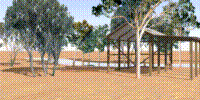 12.8. Applications of Textures
12.8. Applications of Textures  12.8. Applications of Textures
12.8. Applications of Textures Initially the shading parameter (p) was used only for the reflectance or colour of a point on a surface. It has since been used to model environmental reflections, shininess and roughness, surface normal direction and transparency (Peachey, 1985). The surface normal technique allows the simulation of bumps and wrinkles in the surface.
To see some raytraced images which make use of texturing properties to alter image properties such as surface normals and transparency, click here.
The image "lumpy_balls.tiff.Z" is a good example of applying the concept of texture mapping to alter image properties other than the surface colour. Here, a bump map is used to alter the surface normals, changing the way light rays reflect off the spheres to give them a "lumpy" appearance.
The Computer Animation Negus Picture Gallery contains lots of images which make use of textures.
Simon Crone has done quite a lot of work generating images using raytracing and radiosity techniques. These images include some tricky usage of textures.
In particular let's look at his forest image. Notice the
high level of detail on the trees. They also have shadows!
The trees were created by placing digitized textures over
transparent blocks. In this instance, we do not want to see any
part of the object which is not part of the tree. These parts
are declared to be transparent. These are two methods of hiding
the way in which scenes are created. The viewer is unaware of
the underlying geometry of the scene.

Fig. 12.9 : forrest - 24 bit jpg format ( 156104 bytes. )
This method of displaying complex objects is very useful because it saves on defining thousands of polygons for each tree. The raytracer is still able to create shadow effects etc. without having to perform many more (x1000's) ray/object intersection tests.












